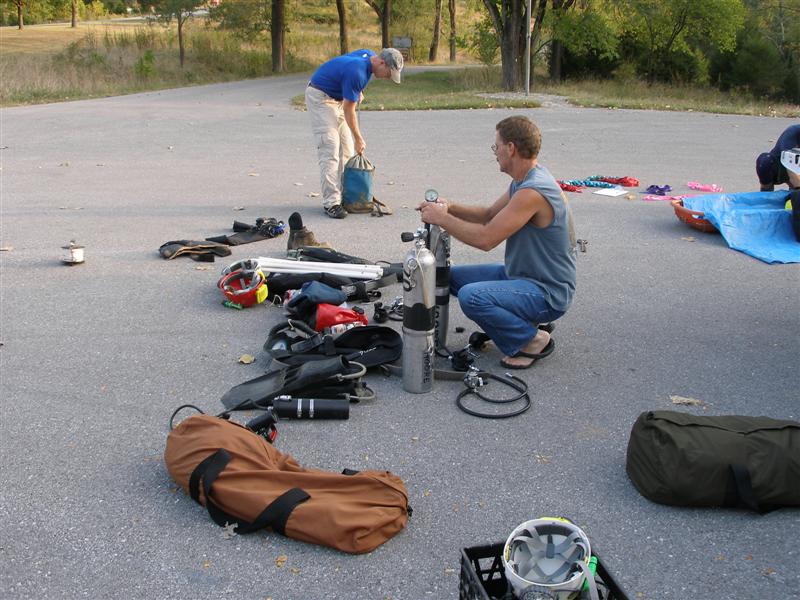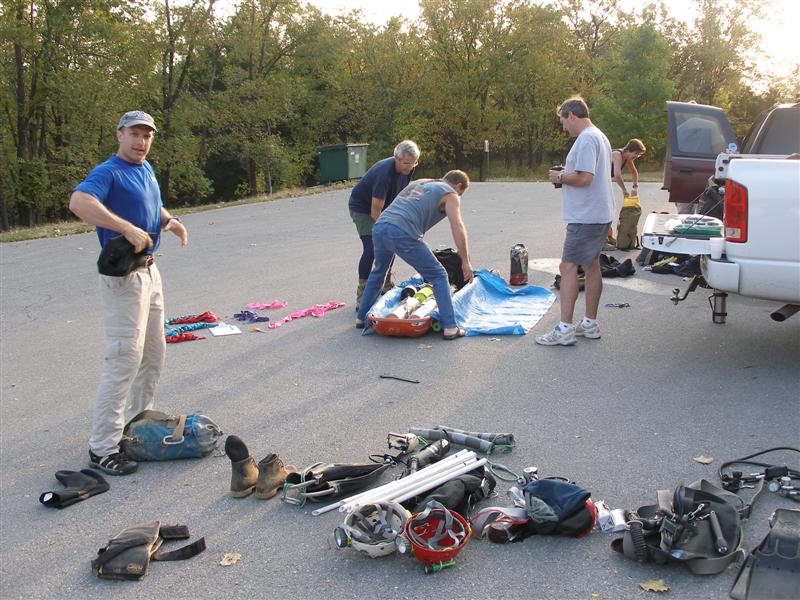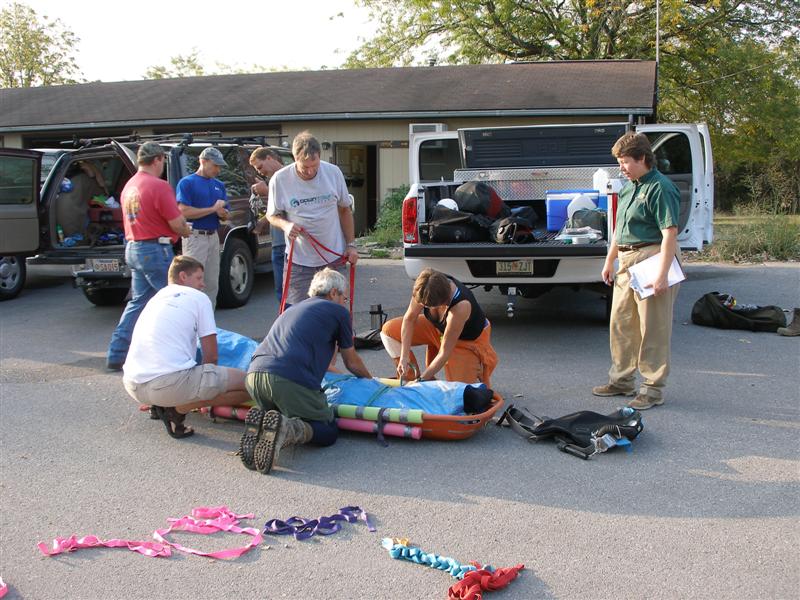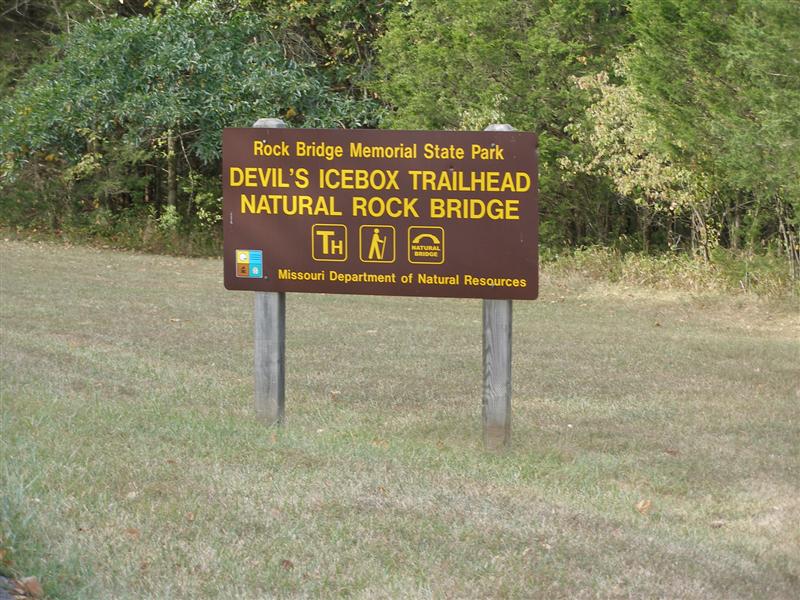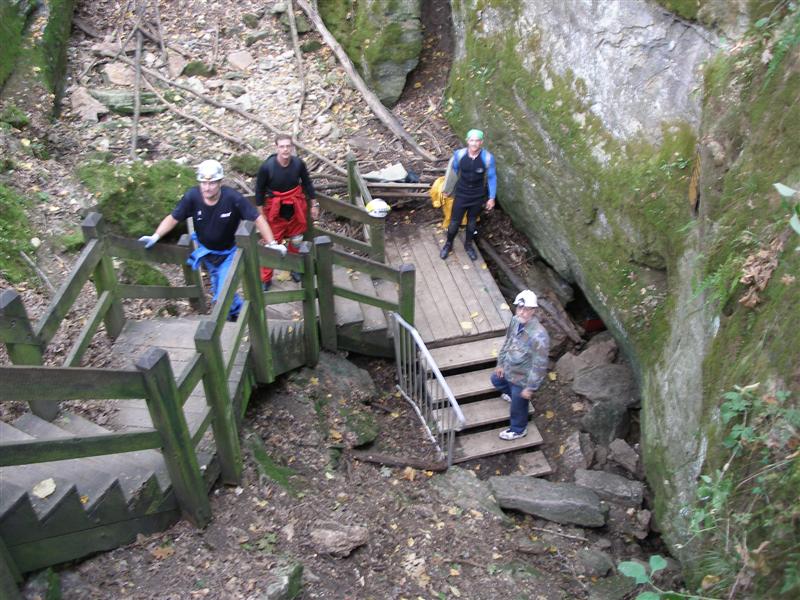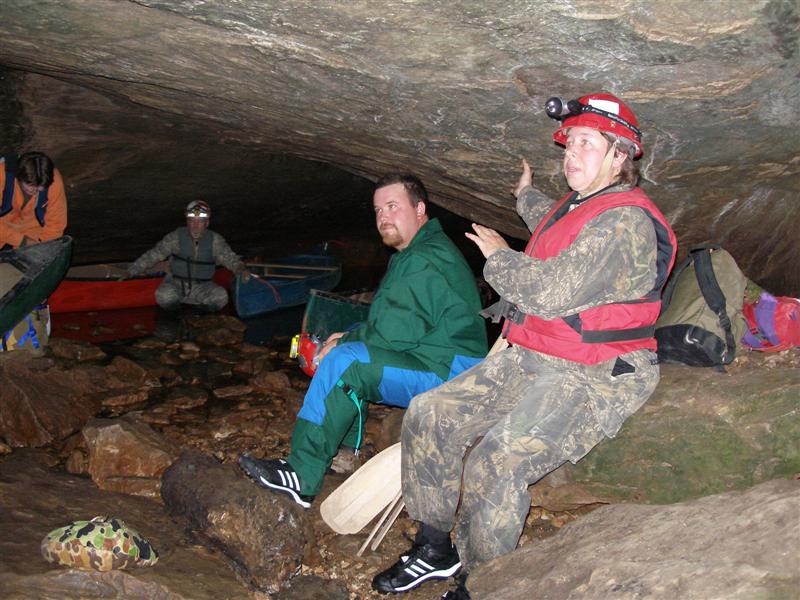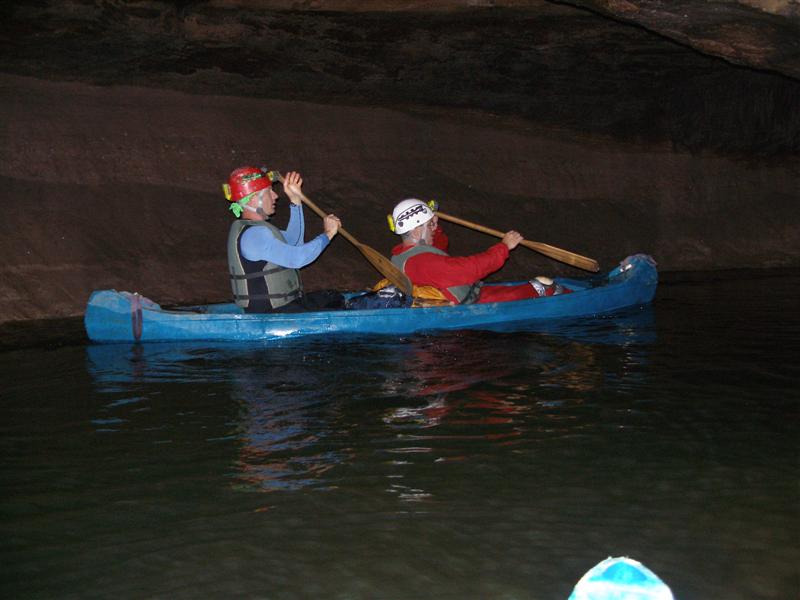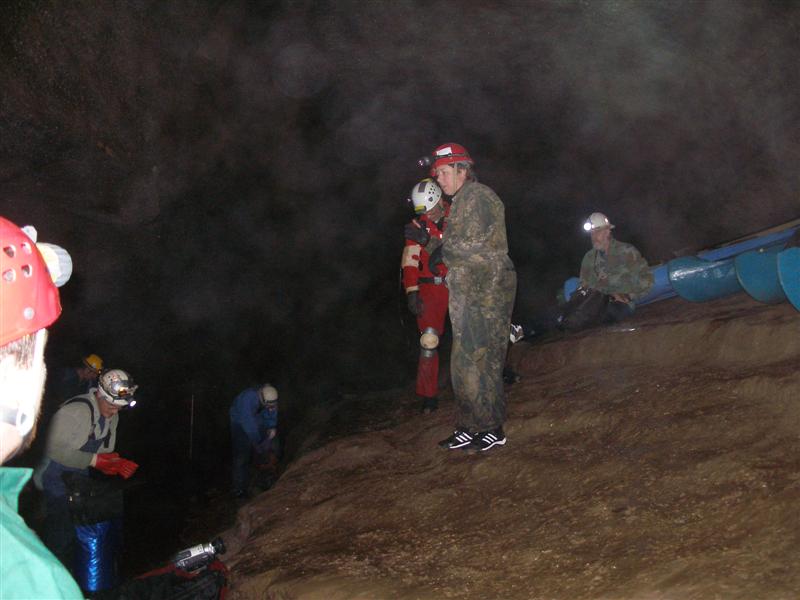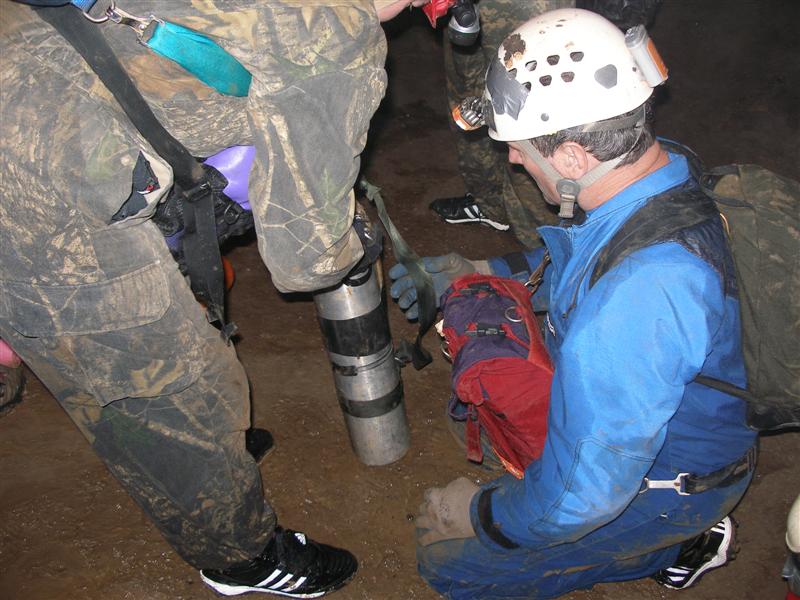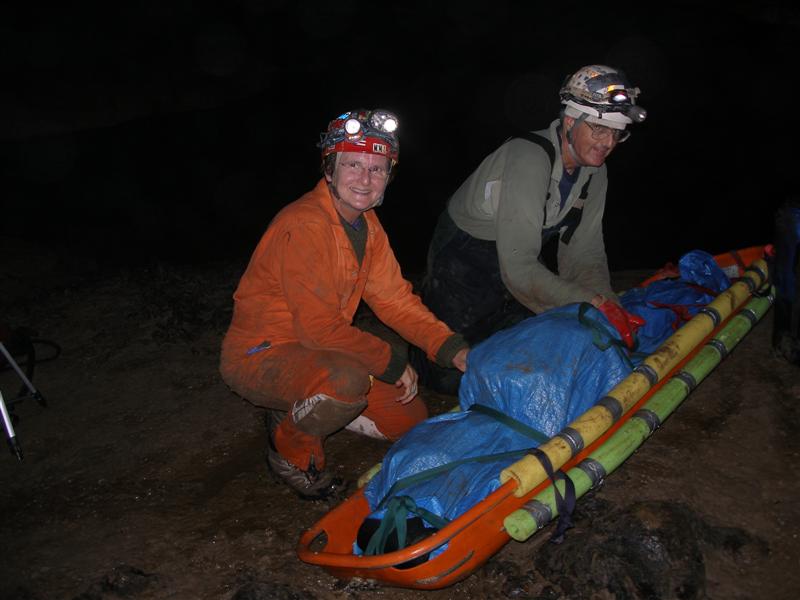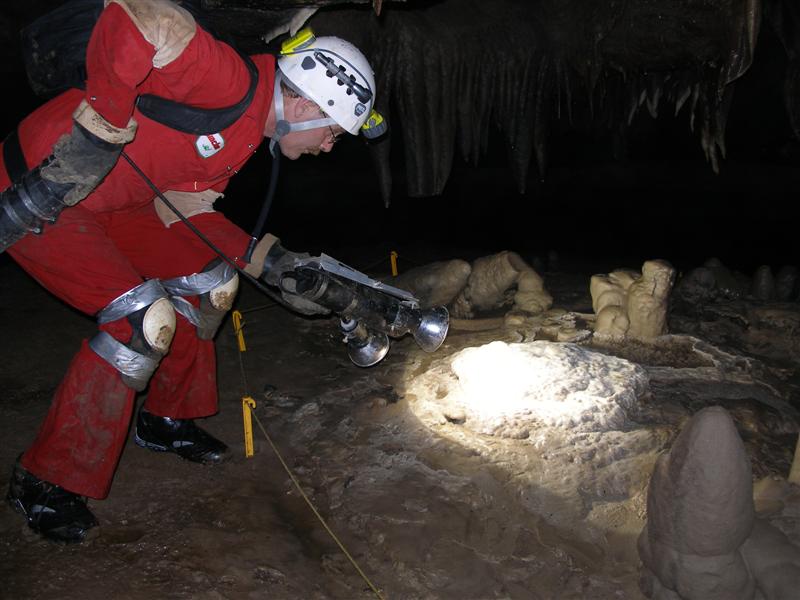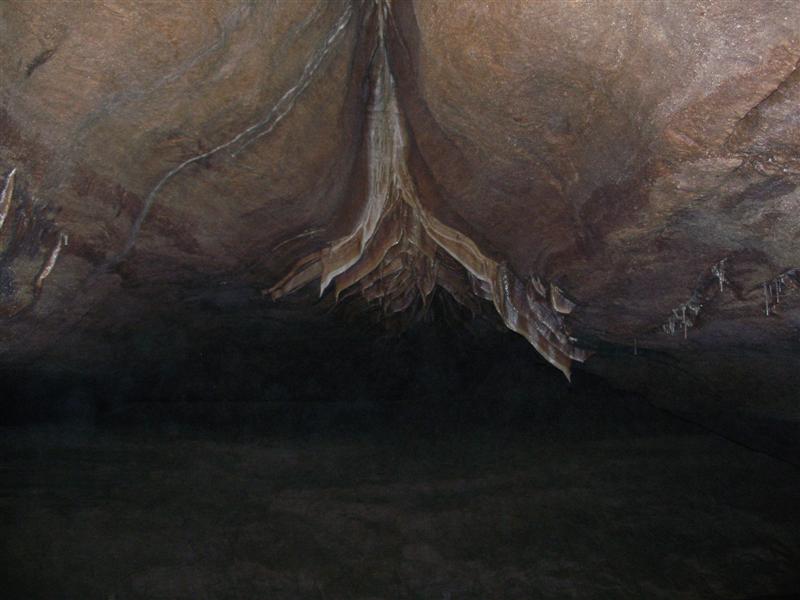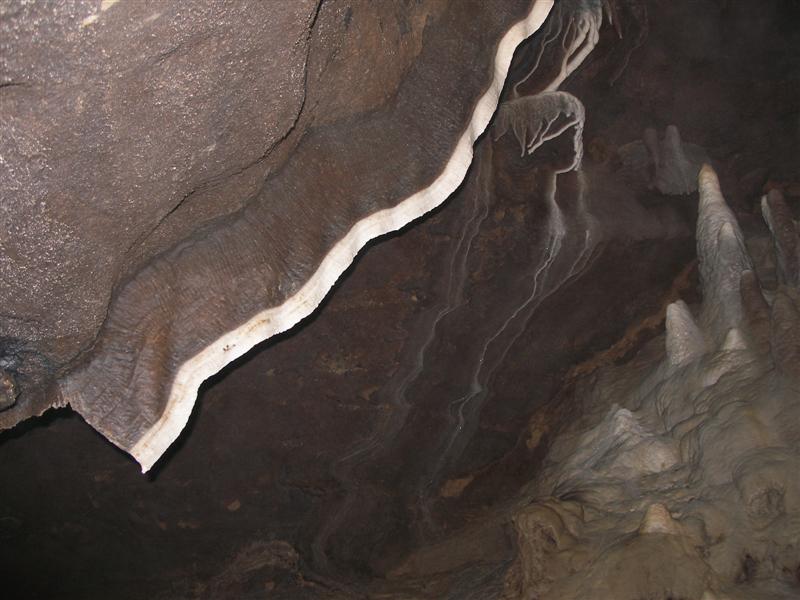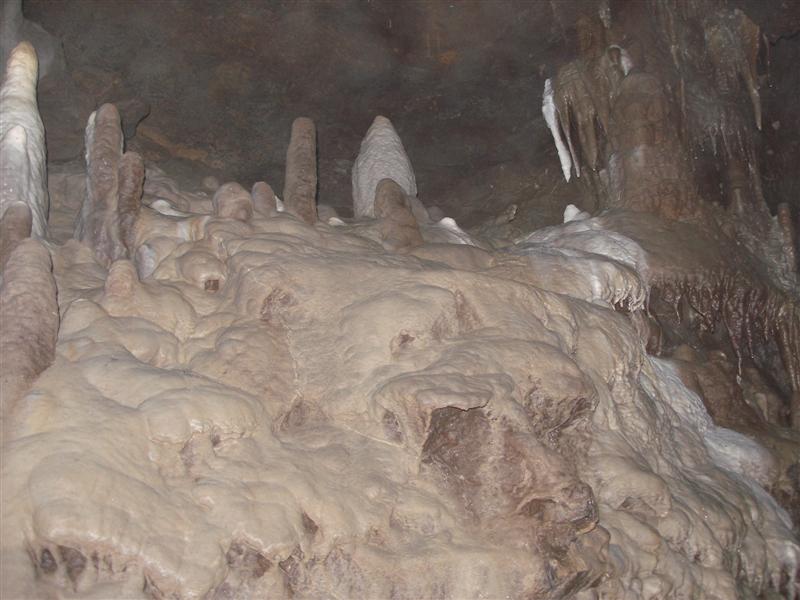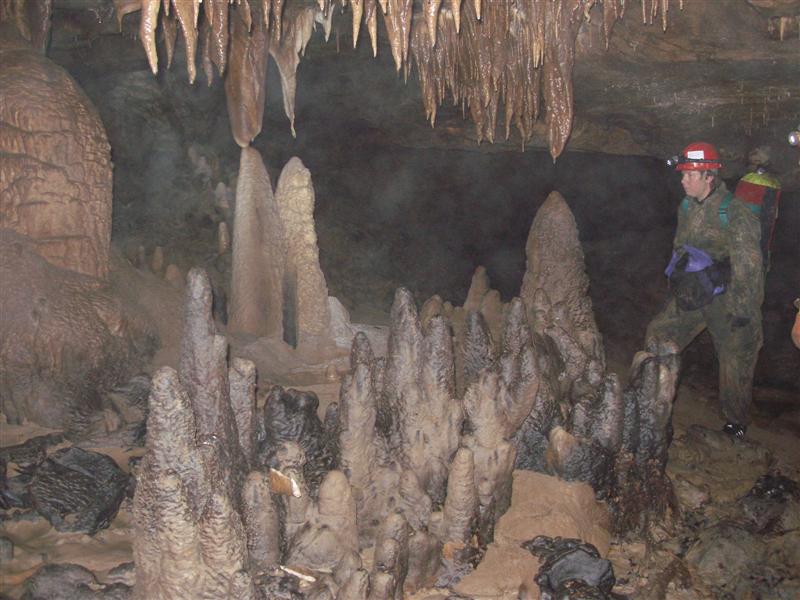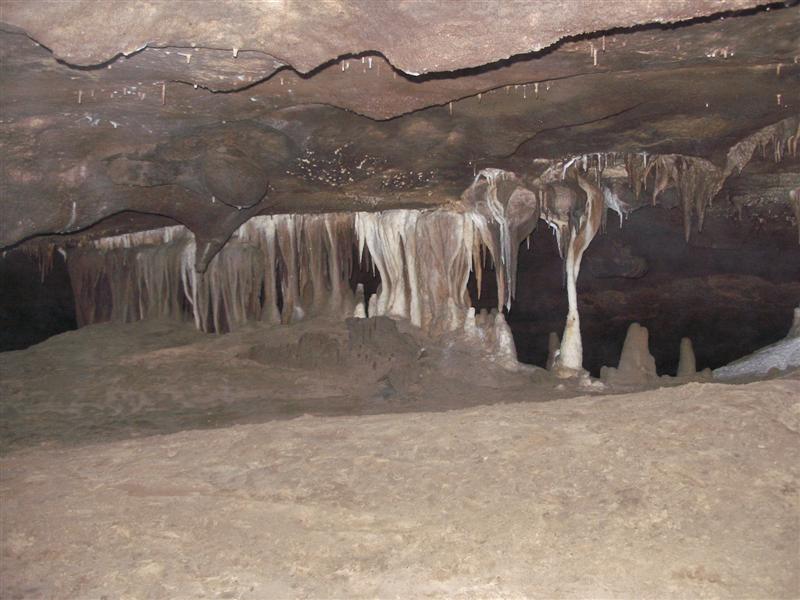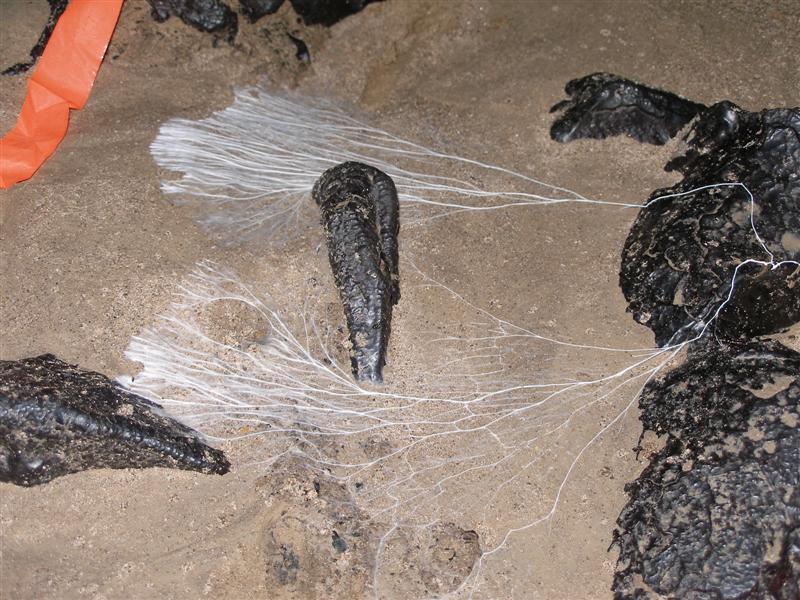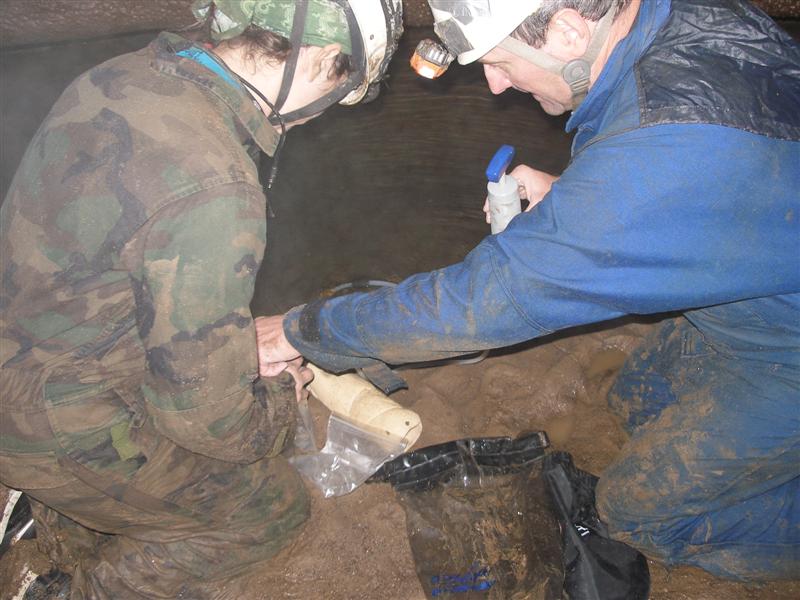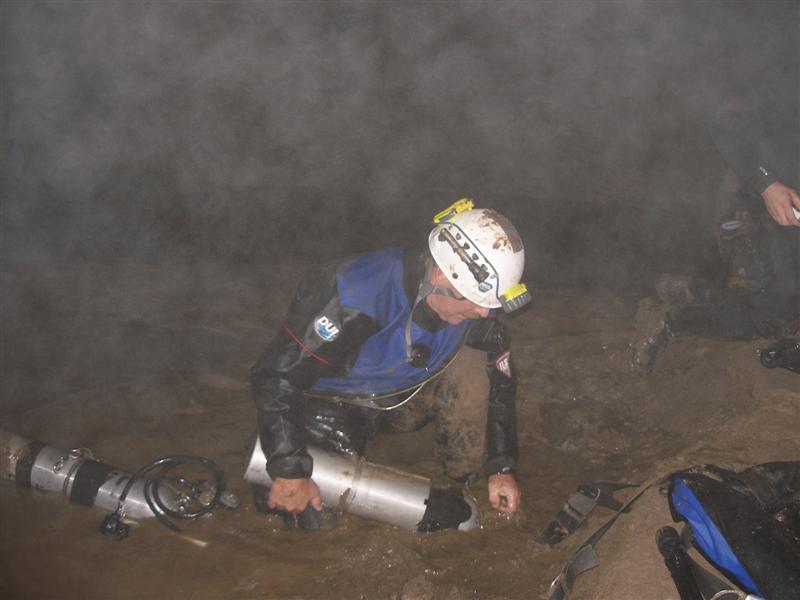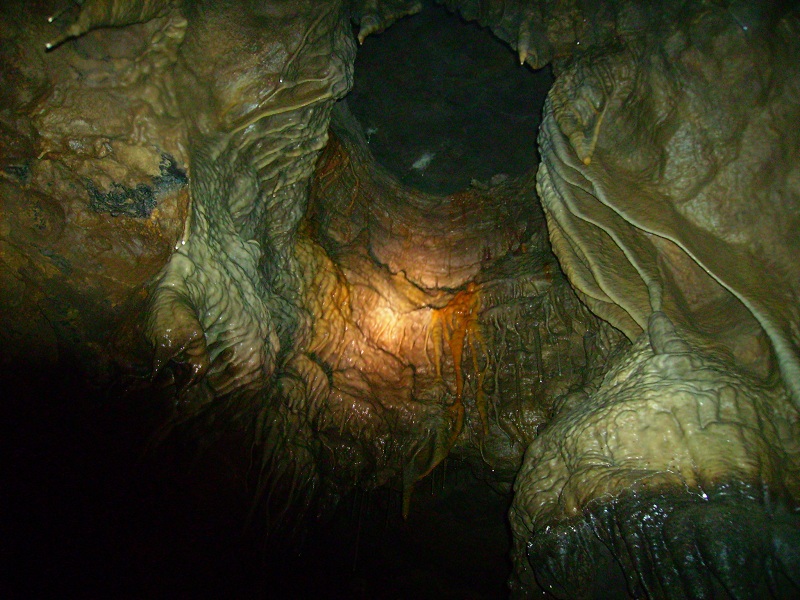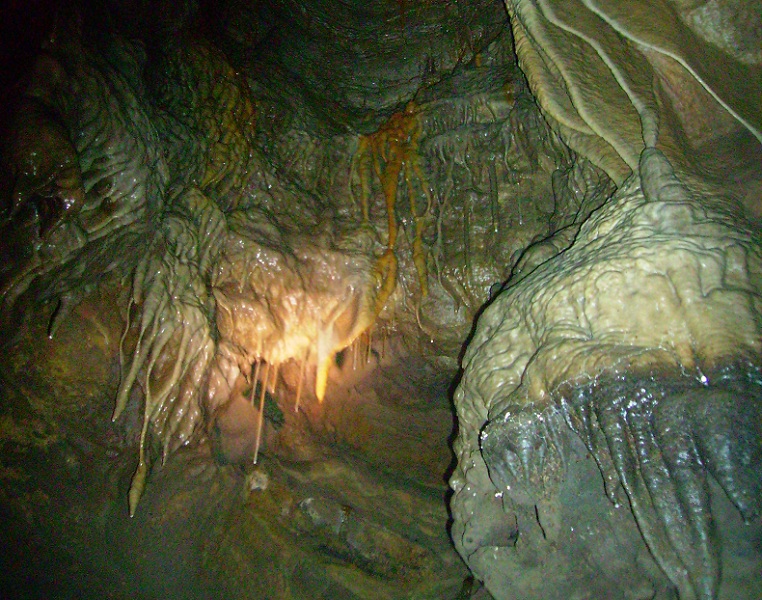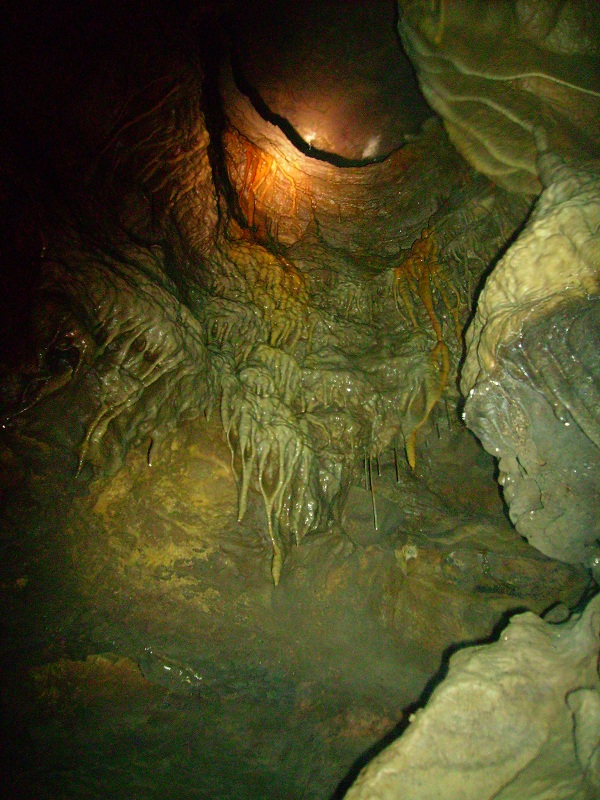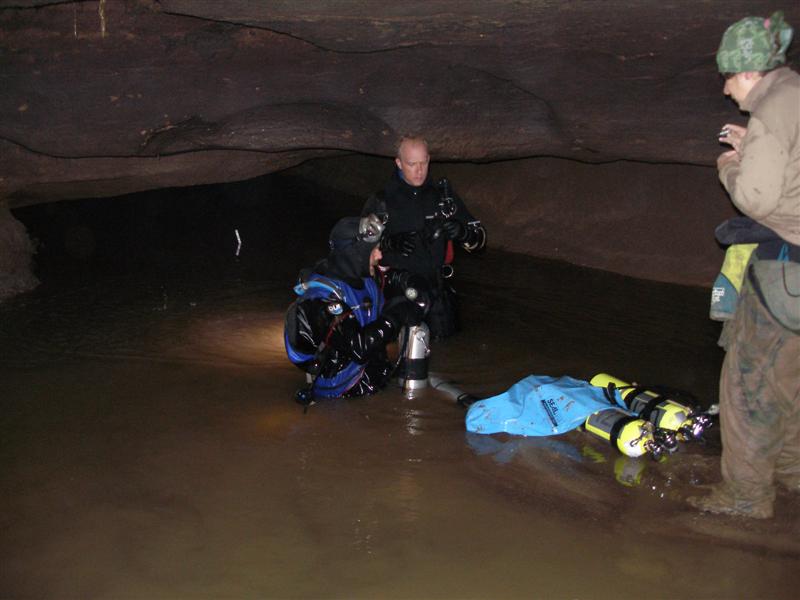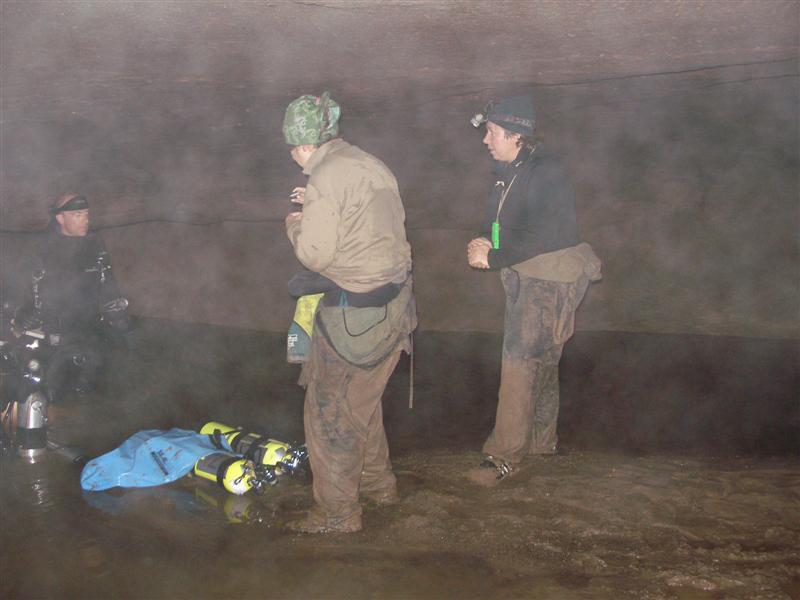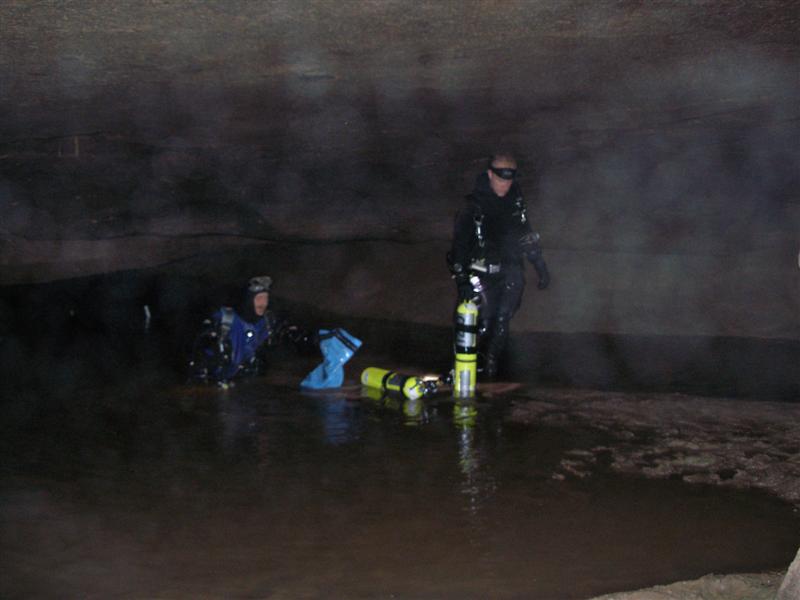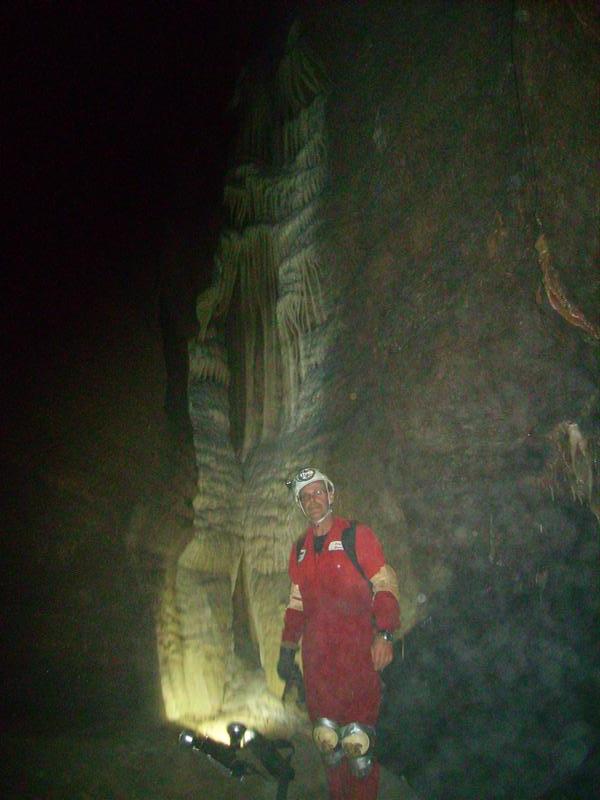LOCATION: Rock Bridge Memorial State Park in Colombia, MO.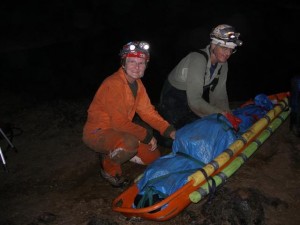
OWNERS: Operated by the Missouri Department of Natural Resources.
DIVING HISTORY: The OCDA was cordially invited to explore two sump areas in the back area of the system to determine if any passages existed beyond what had previously been explored. This involved a 3.5 mile trip into the system to start the exploration.
On September 22, 2007 our party of 7 arrived at the park office within Rock Bridge Memorial State Park at 7:30 am to meet with other spelunkers and Wild Cave Tour group leaders who were to assist in moving dive gear into the cave system. Representing the OCDA were Shannon Wallace, Brian Moore, Bob Koch, and potential members Susan Thrasher, Chris Rottler, Mike Tanner, and Shawn Sorah. Beforehand it was decided that a rescue litter would be used to haul most of the scuba gear through the system. Logistics required four 40cf tanks and 2 back plates for 2 divers, with another backup diver fully suited to step in if needed. Everything was secured and packed and then we all sat down for a safety meeting to discuss the trip agenda. Roxie Campbell with the Department of Natural Resources is in charge of the Wild Cave Tour. She headed up the meeting and passed out liability releases. After talking about several trip objectives we headed out to the cave parking lot a mile away to move the canoes up the .5 mile trail and down the stairs to the cave system itself. Getting the gear to the actual takeoff point of the trip is a bit of an undertaking. Getting started about 9:30am the first half mile of the cave system was water passage traversed by 2 people per canoe. There are about half a dozen portages that the canoes have to be pulled over or through, more than usual due to the low water level. At the end of the canoe passage is the beach area where the canoes are pulled up the bank and left for the return trip. From this point here the inbound hike starts. Things went well for a while until we started getting into the rocky areas where the litter crew started having some difficulties. It was decided then that the tanks should be removed from the litter to lighten the load. Slings were brought out and the tanks were divided up. Progress was steady with the litter team staying to the stream passage where possible since it was outfitted with flotation and could be pulled through the water with ease. In the meantime we were filming the whole trip with emphasis on creating a short video for park visitors to watch that might be interested in signing up for the Wild Cave Tour. Park Naturalist Roxie Campbell explained features of interest in the cave pointing out sections that the 4 different cave tours would get people into, tours A thru D with increasing difficulty. Brian brought in his hid rig to really light up the larger sections of the system. There were also a couple places where you get wet going through some water passages including one called “The Swim”. With all this going on it took us about 6 hours to get back to the first objective which was sump 3900m, being 3900 meters back in the system as the name implies. Brian and Shannon made a quick scouting of the sump, and after conferring with Roxie, it was decided to move farther inbound to sump 4200m to start the dive exploration. After everyone had arrived at that point Brian and Shannon started gearing up while the dry cavers hunkered down and started filtering water and firing up their stoves for hot soup and drink. I’ve never seen so many stoves in a cave before. At one point it looked like someone had a table cloth spread out. This group of cavers really knew how to kill time underground comfortably, to be sure! Brian and Shannon entered the sump at 5:25pm and returned about 7:00pm, 15 minutes before they would be overdue. They reported a short 60’ sump with 8’ depth and long walking passage beyond which they explored for about 1,300 feet. While it was originally planned that I should film thru the sump and beyond we fell back to a more conservative plan during the inbound trip when looking at equipment loads and what we were trying to accomplish for the park in the front section of the system. After the 4200m dive the trip was called due to time and we were headed outbound. The trip out was uneventful but with long breaks at the more scenic areas. It sure seemed like there were more canoe portages coming back out of there. From the cave entrance the canoes had to be hauled back up the stairs too numerous to mention and back to the trailer for transport back to the park office where they needed to be scrubbed down and hosed off, along with the life jackets. When it was all said and done it was 2:30am when we were packed up and ready to head out. It was quite a trip, not as difficult as other systems we’ve been in, but the cave made up for it in length.
NOTES: Tours are offered through the Wild Cave Tour program in the spring and fall. April 15-May 16 and August 1 thru October 8th on Saturdays and Sundays. Prices vary depending on the 4 different levels of difficulty. This also involves carrying canoes into the system and floating for the first half mile in. Call ahead as White Nose Syndrome has been reported in the area.
On August 15, 2009 the OCDA and WCT volunteers returned to Devils Icebox Cave to resume pushing 2 leads out in the further reaches of the system. We gathered at the park at 8 am to meet everyone participating in the trip and then had a short trip planning and safety review. Afterwards body weights were recorded, gear for 4 divers was distributed, and packs were then weighed. We then geared up and headed for the cave entrance where canoes and packs had to be hauled down a hill and several staircases to the cave entrance. Here Roxie’s planning was apparent as we were delegated by body and pack weights to the 3 different capacity canoes. It didn’t take long for 9 canoes and 18 people to get sorted out in the small cave entrance and we started off into the water passage. I was fortunate to be paired up with a long time cave guide who knew where all the barely submerged rocks were and showed me some sights I missed out on during the previous 2007 trip. This is a 825 meter passage with 3 portages where canoes must be hauled up and over obstructions before resuming the inbound trip. Shortly afterwards we arrived at the Boat Landing area where we hauled the canoes up a steep bank safely out of harms way. From this point it was 3375 meters back into the system to reach our first sump staging area. There are various scenic points in the cave that were used for break areas and we kept up a pretty good pace considering the amount of gear everyone was carrying. Once we arrived at the 4200m staging area all the dive gear was unpacked and distributed. Someone whipped up hot water and that hot noodle lunch never tasted so good as we got things together. The first dive team of Bennett/Wallace entered the 4200m sump about 4:30pm to seek out the elusive cave fish with the slightly larger 40cf tanks. The 2nd dive team of Koch/Moore followed on behind 10 minutes later. The sump seems to staircase down to 10’ depth and the ceiling does clobber you in the head due to the zero visibility we encountered, typical conditions following another team through. As we surfaced on the far side of the sump we were greeted with a high narrow water filled passage. Dirk and Shannon were already setting survey stations as we surfaced and reported that they hadn’t spotted a cave fish in the limited visibility water inbound. It took a minute to find a suitable spot to dig my camera out of the waterproof bag that I had packed in thru the sump. Once we were up and running we grabbed some footage of the survey crew working and then moved forward to look for fish in the shallow stream area ahead of us.
Brian took point and slowly scanned the water while I followed on. Initially we found walking stream passage but as we traveled farther inbound we would hit low and wide areas to crawl through. We spent 5 minutes looking for pink planarian in one straight section but spotted nothing but what appeared to be 2 surface fish resembling minnows. We did spot a tiny dead frog on a bank where Brian said a small white critter was eating it.
Just upstream of this point we found a very small junction to the left that had a dome above it, After crawling up and into the area below the dome we spotted another higher dome to one side. With the hid lighting that we brought in we had a pretty good look at it and decided to wait on the survey crew to observe the helium balloon inflation and height confirmation of the domes. Dirk and Shannon caught up with us shortly afterwards and we took a short break while looking at the dome area. It was then we found that the 6cf helium tank plug would not cooperate and come out as planned. The tank valve had apparently opened during the inbound journey and the pressure held the plug fast, at least with the limited tools that we had with us. After fighting the problem for 5 minutes we retired the tank and continued inbound. Brian and I picked up the pace a bit as we moved forward but still scanned the stream bed for anything of interest. If an area of the system looked scenic I would setup to capture it as we moved by. Brian briefly checked out a low mud crawl lead to the left. As we continued inbound the stream passage widened with a real low ceiling. Lens fogging became an issue here more than once even though I had used some anti-fog product on the lens. We finally came to a point inbound where the passage turned into a wide ear dip and we called the trip on account of time and the fact we were losing body heat in the water. We encountered the survey team of Bennett/Wallace shortly afterwards who were making great time grabbing data. Brian and I returned to the sump to exit the 4200m passage around 8:10pm with Dirk and Shannon exiting at 8:20pm. I noticed everyone was wearing a heat tent while waiting for us to exit. Hot water was waiting for us to whip up some hot food before we packed up and got the 2 different groups heading outbound. This really helped out, let me tell you. After a discussion with Roxie it was decided the Bennett/Wallace team would checkout the 3900m sump area while outbound. After arriving in that area dive gear was distributed and one group of cavers started the outbound journey to speed up the exit process. A small group assisted the divers in getting gear into the sump area. The dive team reported a small diameter sump passage which again surfaced shortly after starting. Shannon reported hearing support team voices at the upstream end of the sump. I had noticed several holes in the ceiling area so there is apparently another way in though hard to access. We once again started outbound, regrouped at the 3900m junction, and packed up for the long haul out of the cave system. At this point it was getting late and it was a challenge to keep one’s footing on the wet rocks and to try to avoid hitting submerged rocks and ledges as we slogged though the stream passages waist deep in places.
We eventually arrived at the Boat Landing area catching up with group 1 in the process. Gear was loaded into the canoes and we headed out for an uneventful canoe ride. The portages seemed a bit longer this time. We exited the cave to haul the canoes and packs up the stairs and to the top of the hill where transportation was waiting. We regrouped back at the park building to clean canoes and retrieve gear from all the volunteers that helped us out during the trip. This was a great trip and logistically speaking, a challenge to get all the gear for 4 divers 4200 meters back into the cave system. Heavy packs were worn by all. We can’t say enough for all the effort expended by the Wild Cave Tour volunteers and others! It looks like there is more cave to discover in the system so we’ll find more ways to lighten our gear to make this process easier. It was another long day for all.
Bob Koch

